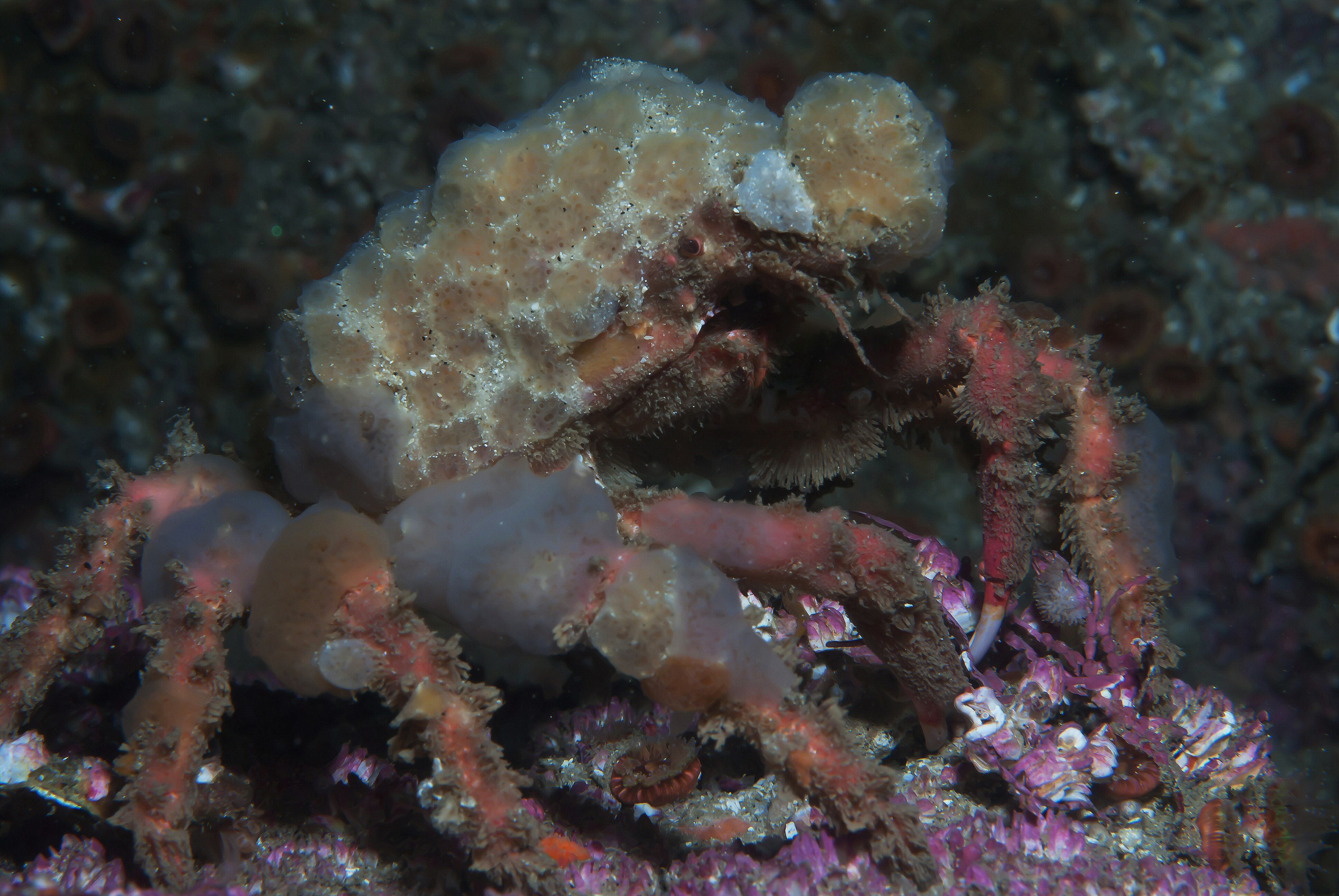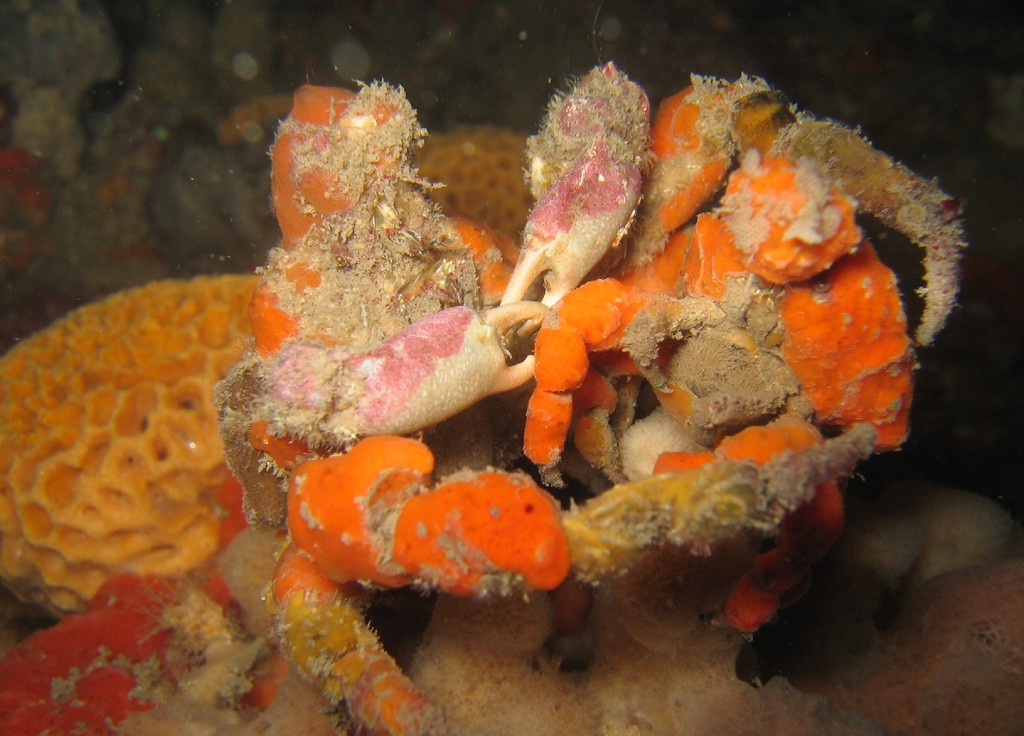Decorator Crab on:
[Wikipedia]
[Google]
[Amazon]
 Decorator crabs are
Decorator crabs are
 Cott described the decorator crabs as using "concealment afforded by masks of adventitious material", giving as example the great spider crab ''
Cott described the decorator crabs as using "concealment afforded by masks of adventitious material", giving as example the great spider crab ''
SeaDB: World Database of Marine Species: Decorator Crabs
(list of species, photographs, videos) {{Camouflage Majoidea Camouflage
 Decorator crabs are
Decorator crabs are crab
Crabs are decapod crustaceans of the infraorder Brachyura, which typically have a very short projecting "tail" (abdomen) ( el, βραχύς , translit=brachys = short, / = tail), usually hidden entirely under the thorax. They live in all the ...
s of several different species, belonging to the superfamily Majoidea
The Majoidea are a Superfamily (taxonomy), superfamily of crabs which includes the various spider crabs.
Taxonomy
In "''A classification of living and fossil genera of decapod crustaceans''" De Grave and colleagues divided Majoidea into six fa ...
(not all of which are decorators), that use materials from their environment to hide from, or ward off, predators. They decorate themselves by sticking mostly sedentary animals and plants to their bodies as camouflage
Camouflage is the use of any combination of materials, coloration, or illumination for concealment, either by making animals or objects hard to see, or by disguising them as something else. Examples include the leopard's spotted coat, the ...
, or if the attached organisms are noxious, to ward off predators through aposematism
Aposematism is the advertising by an animal to potential predators that it is not worth attacking or eating. This unprofitability may consist of any defences which make the prey difficult to kill and eat, such as toxicity, venom, foul taste or ...
.
History
In 1889,William Bateson
William Bateson (8 August 1861 – 8 February 1926) was an English biologist who was the first person to use the term genetics to describe the study of heredity, and the chief populariser of the ideas of Gregor Mendel following their rediscove ...
observed in detail the way that decorator crabs fix materials on their backs. He noted that "the whole proceeding is most human and purposeful", and that if a ''Stenorhynchus
''Stenorhynchus'' is a genus of marine crabs in the family Inachidae, containing the following species:
*'' Stenorhynchus debilis'' (S. I. Smith, 1871)
*'' Stenorhynchus lanceolatus'' (Brullé, 1837)
*''Stenorhynchus seticornis
''Stenorhync ...
'' crab is cleaned, it will "''immediately'' begin to clothe itself again with the same care and precision as before".
In his ''The Colours of Animals
''The Colours of Animals'' is a zoology book written in 1890 by Sir Edward Bagnall Poulton (1856–1943). It was the first substantial textbook to argue the case for Darwinian selection applying to all aspects of animal coloration. The book al ...
'' (1890), Edward Bagnall Poulton
Sir Edward Bagnall Poulton, FRS HFRSE FLS (27 January 1856 – 20 November 1943) was a British evolutionary biologist, a lifelong advocate of natural selection through a period in which many scientists such as Reginald Punnett doubted its i ...
classified protective animal coloration
Animal coloration is the general appearance of an animal resulting from the reflection or emission of light from its surfaces. Some animals are brightly coloured, while others are hard to see. In some species, such as the peafowl, the male h ...
into types such as warning colours
Aposematism is the advertising by an animal to potential predators that it is not worth attacking or eating. This unprofitability may consist of any defences which make the prey difficult to kill and eat, such as toxicity, venom, foul taste or ...
and protective mimicry
In evolutionary biology, mimicry is an evolved resemblance between an organism and another object, often an organism of another species. Mimicry may evolve between different species, or between individuals of the same species. Often, mimicry f ...
. He included self decoration under the heading "Adventitious Protection", quoting Bateson's account of decorator crabs.
In his ''Adaptive Coloration in Animals
''Adaptive Coloration in Animals'' is a 500-page textbook about camouflage, warning coloration and mimicry by the Cambridge zoologist Hugh Cott, first published during the Second World War in 1940; the book sold widely and made him famous.
The ...
'' (1940), Hugh Bamford Cott
Hugh Bamford Cott (6 July 1900 – 18 April 1987) was a British zoologist, an authority on both natural and military camouflage, and a scientific illustrator and photographer. Many of his field studies took place in Africa, where he was especia ...
describes self decoration under the heading "adventitious concealing coloration", also naming it "adventitious resemblance". He describes it as a device "perhaps unrivalled" for effective concealment, and points out that it is brought about and depends on "highly specialized behaviour". Further, it grades into other means of protection including "the borrowing of protection from aposematic
Aposematism is the advertising by an animal to potential predators that it is not worth attacking or eating. This unprofitability may consist of any defences which make the prey difficult to kill and eat, such as toxicity, venom, foul taste or ...
partners" and the use of "fortified hiding-places" and burrows. Cott compares the way Australian aborigines once used water lily leaves over their faces to swim up to waterfowl until they could catch them by the legs.
Camouflage
 Cott described the decorator crabs as using "concealment afforded by masks of adventitious material", giving as example the great spider crab ''
Cott described the decorator crabs as using "concealment afforded by masks of adventitious material", giving as example the great spider crab ''Hyas araneus
The great spider crab, ''Hyas araneus'', is a species of crab found in northeast Atlantic waters and the North Sea, usually below the tidal zone.
In 1986, two specimens were captured at the South Shetland Islands off the Antarctic Peninsula
...
'' of Britain "which disguises itself very perfectly". When ''H. araneus'' specimens were moved from an environment where all the crabs were camouflage
Camouflage is the use of any combination of materials, coloration, or illumination for concealment, either by making animals or objects hard to see, or by disguising them as something else. Examples include the leopard's spotted coat, the ...
d with short pieces of seaweed into different environments, all of them had redecorated themselves with local materials after one night. One was among corallines, and was covered with a dense bush of the hydrozoa
Hydrozoa (hydrozoans; ) are a taxonomic class of individually very small, predatory animals, some solitary and some colonial, most of which inhabit saline water. The colonies of the colonial species can be large, and in some cases the specializ ...
n ''Sertularia abietina
''Sertularia'' is a genus of hydroids in the family Sertulariidae.
Species
The following species are recognized in the genus ''Sertularia'':
*'' Sertularia albimaris'' Mereschkowsky, 1877
*Air Fern
The air fern (''Sertularia argentea'') is ...
''. Another was on small shells and gravel, and was decorated with those. A third was among the crinoid
Crinoids are marine animals that make up the class Crinoidea. Crinoids that are attached to the sea bottom by a stalk in their adult form are commonly called sea lilies, while the unstalked forms are called feather stars or comatulids, which are ...
''Antedon rosaceus
''Antedon'' is a genus of free-swimming, stemless crinoids. The genus first appeared in the fossil record in the Cretaceous period.
Characteristics
Members of this genus have no stems but have five pairs of feathery arms arising from a central ...
'', and had broken off pieces of crinoid arms as decoration.
Bateson, in a much quoted passage, describes crabs of the genera ''Stenorhynchus'' and ''Inachus
In Greek mythology, Inachus, Inachos or Inakhos (Ancient Greek: Ἴναχος) was the first king of Argos, Peloponnese, Argos after whom a river was called Inachos (river), Inachus River,Bibliotheca (Pseudo-Apollodorus), Apollodorus2.1.1/ref> t ...
'': the crab tears a piece of seaweed in its claws, chews it, and then rubs it firmly on its body until it catches on the "Velcro
Velcro, officially known as Velcro IP Holdings LLC and trading as Velcro Companies, is a British privately held company, founded by Swiss electrical engineer George de Mestral in the 1950s. It is the original manufacturer of hook-and-loop fasten ...
-like hooked setae", curved hairs which permit camouflage materials to be attached. The carefully chosen decoration is supplemented by cryptic behaviour, such as remaining still by day, and freezing when predators approach.
Hultgren and Stachowicz (2011) showed that the species of Majoidea
The Majoidea are a Superfamily (taxonomy), superfamily of crabs which includes the various spider crabs.
Taxonomy
In "''A classification of living and fossil genera of decapod crustaceans''" De Grave and colleagues divided Majoidea into six fa ...
whose juveniles camouflage themselves are scattered about the phylogenetic tree – some species do, some do not, and some do so only a little. About 75% of the Majoidea decorate themselves to some extent during at least one phase of their lifecycle, and this number includes all 8 families in that superfamily.
Antipredator defence
Reviewing studies conducted by different authors, Hultgren and Stachowicz showed that some species are highly specialised in their choices of camouflage. For example, ''Pelia tumida Pelia may refer to:
* Pelpa or Pelīā, a village in Iran
* Pelia, a Greek mythological figure
* ''Pelia'' (crab), a genus of spider crabs in subfamily Pisinae of Epialtidae
* ''Peria'' (butterfly) or ''Pelia'', a genus in subfamily Biblidinae ...
'' decorates itself only with sponges; ''Macropodia rostrata
''Macropodia rostrata'', common names, the common spider crab, long-legged spider crab, long-legged crab, is a species of marine crab in the family Inachidae. The Macropodia Rostrata visually mimics many other types of small crabs with the exce ...
'' and ''Libinia dubia
''Libinia dubia'', the longnose spider crab, is a species of crab in the family Epialtidae. It is found in shallow waters on the eastern coast of North America.
Description
The carapace of the longnose spider crab is nearly circular in outline. ...
'' choose the noxious alga ''Dictyota menstrualis
''Dictyota'' is a genus of brown seaweed in the family Dictyotaceae. Species are predominantly found in tropical and subtropical seas, and are known to contain numerous chemicals (diterpenes) which have potential medicinal value. As at the end of ...
'' in some places, while '' Inachus phalangium'' chooses the same alga for the most exposed parts of its body; and ''Stenocionops furcata'' selects the stinging sea anemone '' Calliactis tricolor'' for its carapace. The choice of noxious or stinging organisms as decorations implies that attaching them provides protection from predators by aposematism
Aposematism is the advertising by an animal to potential predators that it is not worth attacking or eating. This unprofitability may consist of any defences which make the prey difficult to kill and eat, such as toxicity, venom, foul taste or ...
rather than by crypsis
In ecology, crypsis is the ability of an animal or a plant to avoid observation or detection by other animals. It may be a predation strategy or an antipredator adaptation. Methods include camouflage, nocturnality, subterranean lifestyle and ...
, and there is direct observational evidence for this, e.g. that octopuses in tanks avoided decorated crabs. The relationship of crab and organisms such as sea anemone
Sea anemones are a group of predation, predatory marine invertebrates of the order (biology), order Actiniaria. Because of their colourful appearance, they are named after the ''Anemone'', a terrestrial flowering plant. Sea anemones are classifi ...
s used as decoration may be mutualistic, offering protection to the crab and food to the anemone.
Species
Decorator crabs come from many different genera, and are distributed worldwide. Some examples are described in the table.References
External links
SeaDB: World Database of Marine Species: Decorator Crabs
(list of species, photographs, videos) {{Camouflage Majoidea Camouflage